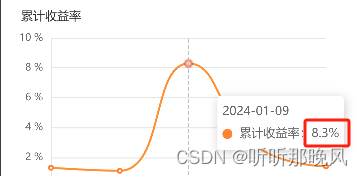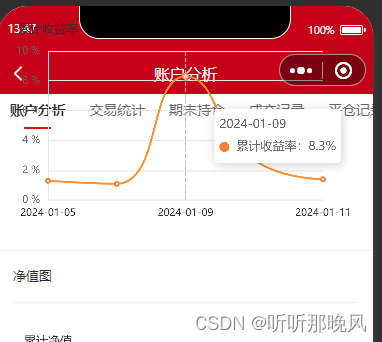uniapp 如何使用echarts 以及解决tooltip自定义不生效问题
发布时间:2024年01月12日
使用的是echarts-for-wx插件;
正常写法案例:给tooltip数值加个%
<template>
<view>
<uni-ec-canvas
class="uni-ec-canvas"
id="uni-ec-canvas"
ref="canvas"
canvas-id="uni-ec-canvas"
:ec="ec"
></uni-ec-canvas>
</view>
</template>
<script>
// 此处将路径替换为你放置该组件的路径
import uniEcCanvas from './uni-ec-canvas/ec-canvas.vue'
export default{
data(){
return {
ec:{
options:{} //echart 配置项
}
}
},
components:{
uniEcCanvas
},
mounted(){
this.initChart()
},
methods:{
initChart(){
this.ec.option={
//其他配置项我就不写了,只展示tooltip
tooltip: {
trigger: 'axis',
confine: true, //提示框限制在图形内
axisPointer: {
type: 'line',
axis: 'auto', // 指示器的坐标轴。
snap: true, // 坐标轴指示器是否自动吸附到点上
},
textStyle: {
// color: "#fff" //设置文字颜色
},
padding: 5, // 提示框浮层内边距,
formatter: (params)=> {
var html = params[0].name + '\n';
//资金使用率添加%
html +=
params[0].marker +
params[0].seriesName +
':' +
params[0].value +
'%'
return html;
}
// backgroundColor: '#ee6461',
},
}
this.$refs.canvas.init();
}
}
}
</script>
// 这里一定要注意 设置该组件宽高 以及display:block来确保canvas初始化的时候是有宽高的
<style>
.uni-ec-canvas{
width:100%;
height:100%;
display:block;
}
</style>
这样的写法formatter自定义是不会生效的;
想要自定义生效的正确写法
this.$refs['canvas'].ec.option={
tooltip: {
trigger: 'axis',
confine: true, //提示框限制在图形内
axisPointer: {
type: 'line',
axis: 'auto', // 指示器的坐标轴。
snap: true, // 坐标轴指示器是否自动吸附到点上
},
padding: 5, // 提示框浮层内边距,
formatter: (params)=> {
var html = params[0].name + '\n';
//资金使用率添加%
html +=
params[0].marker +
params[0].seriesName +
':' +
params[0].value +
'%'
return html;
}
},
}

顺带提一嘴在开发工具上看会有echarts层级太高遮挡显示层问题;这个问题不必理会,真机上显示是正常的

文章来源:https://blog.csdn.net/GongWei_/article/details/135550456
本文来自互联网用户投稿,该文观点仅代表作者本人,不代表本站立场。本站仅提供信息存储空间服务,不拥有所有权,不承担相关法律责任。 如若内容造成侵权/违法违规/事实不符,请联系我的编程经验分享网邮箱:chenni525@qq.com进行投诉反馈,一经查实,立即删除!
本文来自互联网用户投稿,该文观点仅代表作者本人,不代表本站立场。本站仅提供信息存储空间服务,不拥有所有权,不承担相关法律责任。 如若内容造成侵权/违法违规/事实不符,请联系我的编程经验分享网邮箱:chenni525@qq.com进行投诉反馈,一经查实,立即删除!
最新文章
- Python教程
- 深入理解 MySQL 中的 HAVING 关键字和聚合函数
- Qt之QChar编码(1)
- MyBatis入门基础篇
- 用Python脚本实现FFmpeg批量转换
- 工作中常用的免费API接口
- python的库或函数不会用:使用help函数查看函数
- ?水经微图Web1.5.0版即将上线
- 【计算机网络】序列化,反序列化和初识协议
- 老生重谈:大模型的「幻觉」问题
- 【算法】使用位运算解算法题(C++)
- 【MyBatis-Plus】逻辑删除
- 19.(vue3.x+vite)v-if和v-for哪个优先级更高
- 精确掌控并发:滑动时间窗口算法在分布式环境下并发流量控制的设计与实现
- 长虹智能电视48S1刷机升级方法及三种不同配屏刷机数据